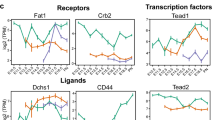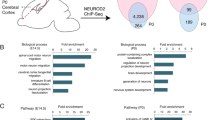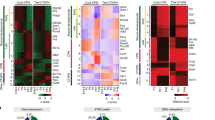Abstract
The fate of cortical progenitors, which progressively generate neurons and glial cells during development, is determined by temporally and spatially regulated signaling mechanisms. We found that the transcription factor Sip1 (Zfhx1b), which is produced at high levels in postmitotic neocortical neurons, regulates progenitor fate non–cell autonomously. Conditional deletion of Sip1 in young neurons induced premature production of upper-layer neurons at the expense of deep layers, precocious and increased generation of glial precursors, and enhanced postnatal astrocytogenesis. The premature upper-layer generation coincided with overexpression of the neurotrophin-3 (Ntf3) gene and upregulation of fibroblast growth factor 9 (Fgf9) gene expression preceded precocious gliogenesis. Exogenous application of Fgf9 to mouse cortical slices induced excessive generation of glial precursors in the germinal zone. Our data suggest that Sip1 restrains the production of signaling factors in postmitotic neurons that feed back to progenitors to regulate the timing of cell fate switch and the number of neurons and glial cells throughout corticogenesis.
This is a preview of subscription content, access via your institution
Access options
Subscribe to this journal
Receive 12 print issues and online access
$209.00 per year
only $17.42 per issue
Buy this article
- Purchase on Springer Link
- Instant access to full article PDF
Prices may be subject to local taxes which are calculated during checkout






Similar content being viewed by others
Accession codes
References
Williams, B.P. & Price, J. Evidence for multiple precursor cell types in the embryonic rat cerebral cortex. Neuron 14, 1181–1188 (1995).
Temple, S. The development of neural stem cells. Nature 414, 112–117 (2001).
Desai, A.R. & McConnell, S. Progressive restriction in fate potential by neural progenitors during cerebral cortical development. Development 127, 2863–2872 (2000).
Morrow, T., Song, M.-R. & Ghosh, A. Sequential specification of neurons and glia by developmentally regulated extracellular factors. Development 128, 3585–3594 (2001).
Bayer, S.A. & Altman, J. Neocortical Development (Raven Press, New York, 1991).
Qian, X. et al. Timing of CNS cell generation: a programmed sequence of neuron and glial cell production from isolated murine cortical stem cells. Neuron 28, 69–80 (2000).
McConnell, S.K. Fates of visual cortical neurons in the ferret after isochronic and heterochronic transplantation. J. Neurosci. 8, 945–974 (1988).
Shen, Q. et al. The timing of cortical neurogenesis is encoded within lineages of individual progenitor cells. Nat. Neurosci. 9, 743–751 (2006).
Barnabé-Heider, F. et al. Evidence that embryonic neurons regulate the onset of cortical gliogenesis via cardiotrophin-1. Neuron 48, 253–265 (2005).
Verschueren, K. et al. SIP1, a novel zinc finger/homeodomain repressor, interacts with Smad proteins and binds to 5′-CACCT sequences in candidate target genes. J. Biol. Chem. 274, 20489–20498 (1999).
Verstappen, G. et al. Atypical Mowat-Wilson patient confirms the importance of the novel association between ZFHX1B/SIP1 and NuRD corepressor complex. Hum. Mol. Genet. 17, 1175–1183 (2008).
van Grunsven, L.A. et al. Delta-EF1 and SIP1 are differentially expressed and have overlapping activities during Xenopus embryogenesis. Dev. Dyn. 235, 1491–1500 (2006).
Dastot-Le Moal, F. et al. ZFHX1B mutations in patients with Mowat-Wilson syndrome. Hum. Mutat. 28, 313–321 (2007).
Van de Putte, T. et al. Mice lacking ZFHX1B, the gene that codes for Smad-interacting protein- 1, reveal a role for multiple neural crest cell defects in the etiology of Hirschsprung disease-mental retardation syndrome. Am. J. Hum. Genet. 72, 465–470 (2003).
Tronche, F. et al. Disruption of the glucocorticoid receptor gene in the nervous system results in reduced anxiety. Nat. Genet. 23, 99–103 (1999).
Goebbels, S. et al. Genetic targeting of principal neurons in neocortex and hippocampus of Nex-cre mice. Genesis 44, 611–621 (2006).
Gorski, J.A. et al. Cortical excitatory neurons and glia, but not GABAergic neurons, are produced in the Emx1-expressing lineage. J. Neurosci. 22, 6309–6314 (2002).
Miquelajauregui, A. et al. Smad-interacting protein-1 (Zfhx1b) acts upstream of Wnt signaling in the mouse hippocampus and controls its formation. Proc. Natl. Acad. Sci. USA 104, 12919–12924 (2007).
Higashi, Y. et al. Generation of the floxed allele of the SIP1 (Smad-interacting protein 1) gene for Cre-mediated conditional knockout in the mouse. Genesis 32, 82–84 (2002).
Wu, S.-X. et al. Pyramidal neurons of upper cortical layers generated by NEX-positive progenitor cells in the subventricular zone. Proc. Natl. Acad. Sci. USA 102, 17172–17177 (2005).
Noctor, S.C., Martinez-Cerdeno, V., Ivic, L. & Kriegstein, A.R. Cortical neurons arise in symmetric and asymmetric division zones and migrate through specific phases. Nat. Neurosci. 7, 136–144 (2004).
Arnold, S.J. et al. The T-box transcription factor Eomes/Tbr2 regulates neurogenesis in the cortical subventricular zone. Genes Dev. 22, 2479–2484 (2008).
Hartfuss, E., Galli, R., Heins, N. & Götz, M. Characterization of CNS precursor subtypes and radial glia. Dev. Biol. 229, 15–30 (2001).
Nieto, M., Schuurmans, C., Britz, O. & Guillemot, F. Neural bHLH genes control the neuronal versus glial fate decision in cortical progenitors. Neuron 29, 401–413 (2001).
Remacle, J.E. et al. New mode of DNA binding of multi-zinc finger transcription factors: deltaEF1 family members bind with two hands to two target sites. EMBO J. 18, 5073–5084 (1999).
Huang, E.J. & Reichardt, L.F. Trk receptors: roles in neuronal signaling. Annu. Rev. Biochem. 72, 609–642 (2003).
Eswarakumar, V.P., Lax, I. & Schlessinger, J. Cellular signaling by fibroblast growth factor receptors. Cytokine Growth Factor Rev. 16, 139–149 (2005).
Kaplan, D.R. & Miller, F.D. Neurotrophin signal transduction in the nervous system. Curr. Opin. Neurobiol. 10, 381–391 (2000).
Grosskortenhaus, R., Pearson, B.J., Marusich, A. & Doe, C.Q. Regulation of temporal identity transitions in Drosophila neuroblasts. Dev. Cell 8, 193–202 (2005).
Gaspard, N. et al. An intrinsic mechanism of corticogenesis from embryonic stem cells. Nature 455, 351–357 (2008).
Eiraku, M. et al. Self-organized formation of polarized cortical tissues from ESCs and its active manipulation by extrinsic signals. Cell Stem Cell 3, 519–532 (2008).
Fukumitsu, H. et al. Brain-derived neurotrophic factor participates in determination of neuronal laminar fate in the developing mouse cerebral cortex. J. Neurosci. 26, 13218–13230 (2006).
Belliveau, M.J. & Cepko, C. Extrinsic and intrinsic factors control the genesis of amacrine and cone cells in the rat retina. Development 126, 555–566 (1999).
Neophytou, C., Vernallis, A., Smith, A. & Raff, M. Muller cell–derived leukaemia inhibitory factor arrests rod photoreceptor differentiation at a postmitotic pre-rod stage of development. Development 124, 2345–2354 (1997).
Zhang, X.M. & Yang, X. Regulation of retinal ganglion cell production by Sonic hedgehog. Development 128, 943–957 (2001).
Waid, D.K. & McLoon, S. Ganglion cells influence the fate of dividing retinal cells in culture. Development 125, 1059–1066 (1998).
Pearson, B.J. & Doe, C.Q. Specification of temporal identity in the developing nervous system. Annu. Rev. Cell Dev. Biol. 20, 619–647 (2004).
Bullough, W.S. L.E. Mitotic control by internal secretion: the role of the chalone-adrenalin complex. Exp. Cell Res. 33, 176–194 (1964).
Lee, S.-J. & McPherron, A.C. Myostatin and the control of skeletal muscle mass. Curr. Opin. Genet. Dev. Commentary 9, 604–607 (1999).
Lander, A.D.G.K., Wan, F.Y., Nie, Q. & Calof, A.L. Cell lineages and the logic of proliferative control. PLoS Biol. 7, e15 (2009).
Zhao, S. et al. Patterning the optic neuroepithelium by FGF signaling and Ras activation. Development 128, 5051–5060 (2001).
Cinaroglu, A.O.Y., Ozdemir, A., Ozcan, F., Ergorul, C., Cayirlioglu, P., Hicks, D. & Bugra, K. Expression and possible function of fibroblast growth factor 9 (FGF9) and its cognate receptors FGFR2 and FGFR3 in postnatal and adult retina. J. Neurosci. Res. 79, 329–339 (2005).
Smith, K.M. et al. Midline radial glia translocation and corpus callosum formation require FGF signaling. Nat. Neurosci. 9, 787–797 (2006).
Barnabé-Heider, F. & Miller, F.D. Endogenously produced neurotrophins regulate survival and differentiation of cortical progenitors via distinct signaling pathways. J. Neurosci. 23, 5149–5160 (2003).
Bartkowska, K., Paquin, A., Gauthier, A.S., Kaplan, D.R. & Miller, F.D. Trk signaling regulates neural precursor cell proliferation and differentiation during cortical development. Development 134, 4369–4380 (2007).
Polleux, F. & Ghosh, A. The slice overlay assay: a versatile tool to study the influence of extracellular signals on neuronal development. Sci. STKE 11 June 2002, l9.
Martynoga, B., Morrison, H., Price, D.J. & Mason, J.O. Foxg1 is required for specification of ventral telencephalon and region-specific regulation of dorsal telencephalic precursor proliferation and apoptosis. Dev. Biol. 283, 113–127 (2005).
Smyth, G. Linear models and empirical bayes methods for assessing differential expression in microarray experiments. Stat. Apple. Genet. Mol. Biol. 3, 3 (2004).
Smyth, G.K., Michaud, J. & Scott, H.S. Use of within-array replicate spots for assessing differential expression in microarray experiments. Bioinformatics 21, 2067–2075 (2005).
Benjamini, Y. & Hochberg, Y. Controlling the false discovery rate: a practical and powerful approach to multiple testing. J. R. Stat. Soc. Series B Stat. Methodol. 57, 289–300 (1995).
Acknowledgements
We thank the Flanders Institute for Biotechnology Microarray Facility, J. Allemeersch and P. Van Hummelen for their skillful analysis of our samples. We thank R. Hevner, D. Ornitz, L. Lei, J. Alberta and C. Stiles for reagents; P. Vanderhaeghen for advice and G. Fishell for numerous discussions. The D.H. laboratory thanks H. Van den Berghe for continuous support. E.S. was a postdoctoral fellow with the Research Foundation Flanders and the Franqui Foundation. This study was supported by the Research Foundation Flanders (G.0288.07), the inter-universitary attraction pole network (IUAP-PAI 6/20) and the EC-FP6 Project Endotrack (LSHG-CT-2006-19050). The V.T. laboratory was supported by Max-Planck Society, Heisenberg Program and Exc 257 of Deutsche Forschungsgemeinschaft, and Fritz Thyssen Foundation. A.N. was a Marie Curie Host Fellow For Early Stage Researchers Training (NEUREST MEST-CT-2004-504193).
Author information
Authors and Affiliations
Contributions
E.S., A.N., A.M., D.H. and V.T. designed the experiments, E.S., A.N., A.M., J.D. and A.S. conducted the experiments, and S.G and K.-A.N. provided Nex-cre mice. V.T. wrote the manuscript and E.S., A.N. and D.H. edited the manuscript.
Corresponding authors
Supplementary information
Supplementary Text and Figures
Supplementary Figures 1–6 (PDF 3796 kb)
Rights and permissions
About this article
Cite this article
Seuntjens, E., Nityanandam, A., Miquelajauregui, A. et al. Sip1 regulates sequential fate decisions by feedback signaling from postmitotic neurons to progenitors. Nat Neurosci 12, 1373–1380 (2009). https://doi.org/10.1038/nn.2409
Received:
Accepted:
Published:
Issue Date:
DOI: https://doi.org/10.1038/nn.2409
This article is cited by
-
Structures and biological functions of zinc finger proteins and their roles in hepatocellular carcinoma
Biomarker Research (2022)
-
Cardiomyocytes stimulate angiogenesis after ischemic injury in a ZEB2-dependent manner
Nature Communications (2021)
-
Enhanced FGFR3 activity in postmitotic principal neurons during brain development results in cortical dysplasia and axonal tract abnormality
Scientific Reports (2020)
-
Temporal plasticity of apical progenitors in the developing mouse neocortex
Nature (2019)
-
An FBXW7-ZEB2 axis links EMT and tumour microenvironment to promote colorectal cancer stem cells and chemoresistance
Oncogenesis (2019)



